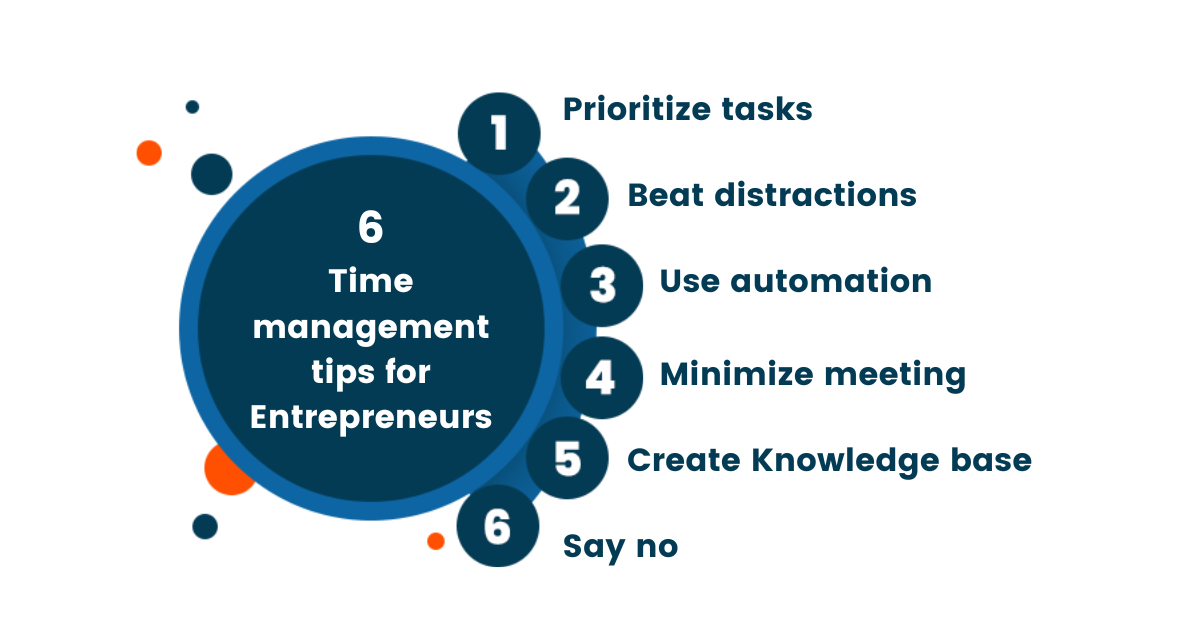
Do you know the biggest trait of successful entrepreneurs and business owners?
They ruthlessly guard their time and focus on their goals while multitasking and getting things done.
But, running a business means you can’t completely escape daily administrative and repetitive tasks. Add to that the constant barrage of phone calls, social media updates, and smartphone notifications, and achieving peak productivity can feel like a distant dream.
But it isn’t impossible.
In this article, we’ll share practical and achievable time management techniques for a busy entrepreneur to help you focus on the highest priority tasks without losing control of day-to-day operations.
The importance of time management skills for SMB owners
As a small and medium-sized business (SMB) owner, you wear many hats. You’re likely the CEO, the marketing director, the customer service representative—the list goes on.
It’s no surprise that the average startup owner works a staggering 50–70 hours a week.
Working long hours is often a part of early-stage entrepreneurship, but it’s important to recognize that you have limited physical and mental energy. And, daily firefighting might feel like work, but it only drains your energy and distracts you from your most critical strategic tasks.
It isn’t sustainable, results in burnout, and ruins your work-life balance.
That’s why you must prioritize your demands so you can spend time your time working “on” your business, providing strategic direction, creating better customer experiences, and finding impactful ways to delegate, automate, or eliminate the rest of the tasks to ensure your business runs smoothly.
Practical time management tips for busy entrepreneurs

You can’t improve what you don’t measure. Before leveraging any time management strategies, you must carefully audit your daily routines and find out where you’re spending your time.
You can do that using time-tracking apps or simply listing everything you do in a spreadsheet at the end of the day. A week’s worth of data should be enough to show your trends and help you identify improvement areas.
Once you have these insights, use the following techniques to optimize your productivity.
1. Use the Eisenhower Matrix to prioritize tasks
The Eisenhower Matrix is one of the most popular tools for prioritizing tasks and managing time effectively.
Here’s how it works.
Take all your tasks and organize them into four quadrants.
Urgent and Important
These are the most critical business tasks that need your immediate attention—a critical customer issue, a limited-time sales campaign, or a project deadline. Prioritize them over everything else.
Important but Not Urgent
These are important tasks that usually contribute to the long-term health of your business—annual planning meetings, learning new skills, and investing in better software. It’s best to schedule them for an appropriate time instead of delaying them indefinitely.
Urgent but Not Important
These are operational and low-skill administrative tasks that are critical to your day-to-day operations but can be easily delegated.
Not Urgent and Not Important
These are time-killers like social media scrolling, useless meetings, or hierarchical formalities that you should eliminate from your life.
Next time you create a to-do list at the start of your workday, run it through this matrix to ensure you prioritize the most important tasks and delegate, schedule, or eliminate the rest.
2. Beat distractions using the Pomodoro Technique
We can’t completely disconnect from social media, emails, or workplace interactions. But we can organize these distractions to ensure they don’t impact our productivity.
This is where the Pomodoro Technique is so effective.
The Pomodoro Technique is a time-management strategy that breaks work down into focused intervals separated by short breaks.
It consists of the following:
- Intervals: Each work period is called a Pomodoro and typically lasts 25 minutes.
- Breaks: Short breaks (usually 5 minutes) follow each pomodoro.
- Sets: After four Pomodoros, there’s a longer break of 20–30 minutes.
Use the breaks to relax, scroll social media, or do anything that usually distracts you from work. But remain fully focused during the work period.
There are no hard and fast rules here. You can change the duration of the intervals and breaks to fit what works best for you.
3. Free up time using automation
Automating business processes and workflows is one of the best ways to free up your time and be more productive. This is where a customer relationship management (CRM) tool like Act! can be a powerful type of time management software for your business.
You can use a CRM to automate your email marketing, lead generation, and customer management workflows. Instead of manually entering customer information into different spreadsheets and spending hours every day searching for the right data, use Act! to organize everything in a customer information dashboard.
It provides you with insightful information and ensures you spend more time making business decisions based on customer insights instead of managing spreadsheets.
4. Minimize meetings with asynchronous communication
Meetings cause more than $37 billion in productivity losses every year.
What’s worse? 55 percent of professionals feel the majority of meetings could have taken place over email.
The simple solution? Use asynchronous communication tools like email, screen recordings, voice messages, and project management tools to collaborate more effectively and save time. Only schedule meetings when there’s no better option.

5. Create a knowledge source for your team
You’re a business owner, so naturally, you know the most about your business and how you want your employees to run it for you.
Why not transform this information into a knowledge source with video recordings, articles, guides, and standard operating procedures (SOPs) your employees can use every time they need guidance? This could save you thousands of hours over time and reduce your team’s dependence on you.
6. Learn to say no (often)
Saying no to anything that doesn’t align with your goals or vision is a superpower every business owner needs.
Steve Jobs was famous for doing that at Apple. But it also works for small businesses because your team, investors, or business partners can sometimes try to pull you into tasks that aren’t worth your time.
Learn to say no more often than yes, and you’ll be much more productive than your competitors.
Create daily habits and routines to get more done
Ultimately, your productivity as an entrepreneur comes down to creating productive daily routines that drive your day.
Having a routine means less uncertainty, distractions, and surprises. As a result, you’re able to focus on long-term goals and spend more time working “on” your business.
Of course, you’ll still need to dive into the operational stuff from time to time.
But that’s where prioritizing, delegating, and most importantly, automating your tasks will help you with effective time management.
To get started with automating tasks and freeing up your time, give Act! a free 14-day trial.




